Second Chorus Blu-ray Movie
HomeSecond Chorus Blu-ray Movie 
Swing Romance / Blu-ray + DVDFilm Chest | 1940 | 80 min | Not rated | May 14, 2013
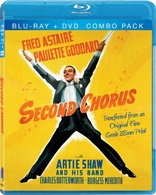
Movie rating
6.4 | / 10 |
Blu-ray rating
| Users | 2.5 | |
| Reviewer | 2.5 | |
| Overall | 2.5 |
Overview
Second Chorus (1940)
Danny O'Neill and Hank Taylor, friendly-enemy musicians who after spending seven years in a college band aspire to join the Artie Shaw Orchestra. Danny and Hank also spend a lot of time vying over the attentions of their pretty manager Ellen Miller.
Starring: Fred Astaire, Paulette Goddard, Artie Shaw, Charles Butterworth, Burgess MeredithDirector: H.C. Potter
| Romance | Uncertain |
| Musical | Uncertain |
| Comedy | Uncertain |
Specifications
Video
Video codec: MPEG-4 AVC
Video resolution: 1080p
Aspect ratio: 1.34:1
Original aspect ratio: 1.37:1
Audio
English: DTS-HD Master Audio Mono
Subtitles
Spanish
Discs
25GB Blu-ray Disc
Two-disc set (1 BD, 1 DVD)
DVD copy
Playback
Region A, B (C untested)
Review
Rating summary
| Movie | 2.5 | |
| Video | 3.5 | |
| Audio | 2.0 | |
| Extras | 1.5 | |
| Overall | 2.5 |
Second Chorus Blu-ray Movie Review
Second string.
Reviewed by Jeffrey Kauffman June 20, 2013Astaire and Rogers? Sure. Astaire and Caron, Astaire and Charisse, Astaire and Miller, Astaire and Vera-Ellen, Astaire and Garland, Astaire and Hepburn, Astaire and Clark? Well, now you’re separating the men from the boys, so to speak. But Astaire and Goddard? Who knew? Virtually any film fan worth his or her salt will recognize the icomparable pairing of Fred Astaire and Ginger Rogers, the ineffably elegant partnering which redefined dance in film. But those other partnerships listed above may serve to offer a head scratch or shoulder shrug, with only true aficionados able to know instantly which films featured those pairings. Probably by far the least generally known of all of Fred’s dance partners, at least with regard to his heyday as a major film star, is Paulette Goddard, his co-star (and actual top billed performer) in 1940’s middling Second Chorus, an independent production from Paramount regular Boris Morros which was initially released under the Paramount banner. The film was re-released in 1947 under the little remembered Astor Pictures imprint (the version presented here), and then it largely disappeared, consigned to occasional airings on television, at least until 1967, when the film’s copyright lapsed and it became fair game for any and all takers. Second Chorus began showing up much more regularly on television, and once the home video revolution got underway, it started showing up in a number of increasingly hideous public domain versions, offerings that often looked like copies of copies of copies. The film is not one of Astaire’s finer efforts; he had recently ended his long partnership with Rogers and he was still finding his sea legs, as it were (as commentator Tom Santopietro mentions, Rogers moved on to an Oscar for Kitty Foyle at almost the exact same time Astaire was shooting Second Chorus, leading Astaire to send her a one word telegram stating merely “Ouch”). Astaire evidently called Second Chorus his worst film, an opinion shared more or less by co-star Artie Shaw, who attributed the rigors of shooting this piece to putting him off a nascent film career.
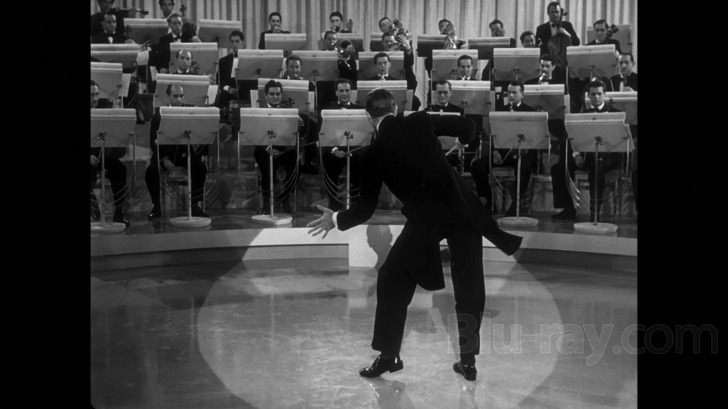
Second Chorus is at its core a silly film that tries, repeatedly, to make a love triangle (or maybe even a quadrangle) where there simply isn’t one. Astaire plays Danny O’Neill, a rather long in the tooth college student who has kept his student status (rather like Raskolnikov) so that he can continue to lead a college band. He conducts and plays trumpet, and is regularly competing with his band’s other featured trumpeter, Hank Taylor (Burgess Meredith). Pretty young Ellen Miller (Paulette Goddard) attends a concert by the boys one night and seems to be flirting with both of them (though perhaps a bit more with Danny), until it’s revealed she’s actually serving Danny with a collection notice.
In one of the film’s rather incredible conceits, Artie Shaw, playing himself, enters the fray because Danny’s band keeps getting all the good gigs. Artie attempts to get Ellen to be his agent, but Ellen wants Danny and Hank to get jobs with Artie. Hilarity supposedly ensues, but Second Chorus is neither madcap nor literate enough to ever really generate much laughter. What the film has in spades is some fantastic music, quite a bit of it by Shaw himself, and a couple of standout dance sequences. Goddard has one big duet with Astaire where she acquits herself reasonably well in an undemanding routine that Rogers could have probably done sleepwalking (or sleepdancing, as the case may be). And Astaire finally cuts loose in the film’s big finale, which finds Fred tap dancing while simultaneously “conducting” Shaw’s band. (For such a consummate musician, which Astaire certainly was, his literal lip synching and fingering during his “tumpet playing” scenes are truly laughable.)
The song score here has a number of cute novelty songs, including Astaire doing a kind of Cossack routine in a café, singing the song’s big romantic ballad “Love of My Life”, a charming ballad co-written by Shaw and the great Johnny Mercer that is also delivered in a straighter fashion elsewhere in the film. The song was nominated for an Academy Award. The film is also notable in that longtime Astaire collaborator and choreographer Hermes Pan actually makes an onscreen appearance. Look for him pretending to play the clarinet in the big Astaire and Goddard duet. Yes, Astaire and Goddard.
Second Chorus Blu-ray Movie, Video Quality 
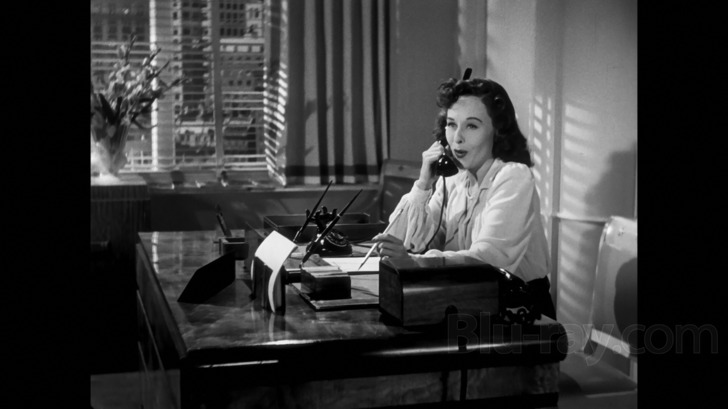
Second Chorus is presented on Blu-ray courtesy of Film Chest with an AVC encoded 1080p transfer in 1.34:1. Film Chest continues to use some odd, potentially ambiguous, phrasing with regard to its Blu-ray releases. Emblazoned across the cover of Second Chorus is the statement "transferred from an original fine grain 35mm print". Do they mean a master positive? Then on the back we're offered another clue: "scanned and restored from 35mm fine grain into 2K (transfer sourced from nitrate)", which would seem to point to a relatively lowly print and not any intermediate element (despite the emphasis on "fine grain"), as should probably be expected of a public domain title. Film Chest has come in for some considerable vitriol from fans for allegedly DNRing its previous releases to death. I personally am less sensitive to DNR than a lot of viewers, and never have felt the evident outrage that some consumers have, but Film Chest has apparently gotten the message as I received an email from them averring that they were completely eschewing DNR on their releases. That may be a bit of an overstatement, as it's evident from the restoration demonstration provided on this Blu-ray that a lot of clean up work was done on this release and with that some very judiciously applied noise reduction looks to have been applied. That said, this is by far the most artful thing we've seen from Film Chest. Make no mistake about it, there is definitely grain on this release, though it may not quite be at the levels some would expect and/or like. Contrast is immeasurably improved (though I found it to be just a tad on the dark side), and the image boasts some very nicely solid blacks and well modulated gray scale. There's some appealing sharpness and clarity in close-ups and even a few midrange shots, though midrange still has some iffy moments, with several shots drifting more toward the fuzzy side of things. The clean-up work done here is quite remarkable, with only a few transitory scratches and a couple of hairs in the gate (some on stock establishing footage) remaining. This is a nice (maybe even a big) step in the right direction for Film Chest. It can't be easy to source these PD titles very well, and often these niche labels are in a "lose-lose" situation. If they do nothing, the transfer ends up looking too shoddy for high definition consumers. If they do too much, they're accused of wiping the slate clean, so to speak. This is overall a nicely balanced presentation.
Second Chorus Blu-ray Movie, Audio Quality 
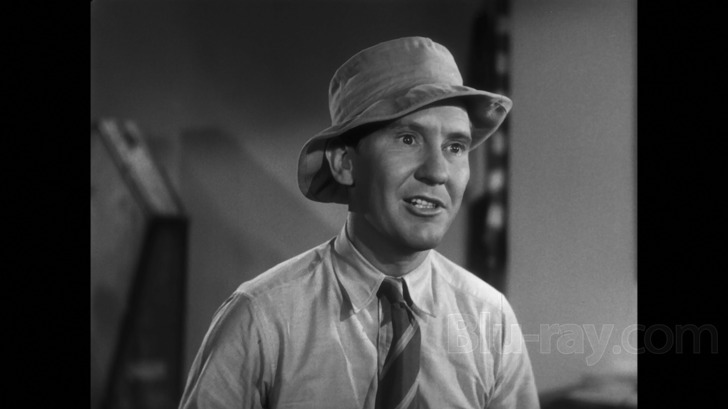
Yikes! Two steps forward, one pretty big step backward. What have they done to Fred's song, ma? Second Chorus's original mono track is presented via DTS-HD Master Audio Mono (2.0), and while it's commendable that Film Chest has gone the lossless route with this release (they haven't always done that), some aspiring audio engineer has processed this track to within an inch of its life. This is of course ironic, considering the criticism this label has come in for with regard to its processing of the visuals. I make some of my living as a professional musician, and so I'm perhaps more attuned (no pun intended) to things like overly compressed or processed audio than some people, but my hunch is even those with a tin ear are going to hear the really badly phased midrange on this track, a situation which makes noisy crowd moments sound like something out of a psychedelic bad trip. (I'm wondering if some of this is due to an attempt to create a fake stereo mix, with phasing between the channels, though I personally detected absolutely no stereo separation here.) This same problem makes a lot of the dialogue sound overly boxy and over- reverbed. The high end fares best here, which is at least good news for some of Artie Shaw's stratospheric clarinet work, but this is a real shame, especially since Second Chorus contains such fabulous music.
Second Chorus Blu-ray Movie, Special Features and Extras 
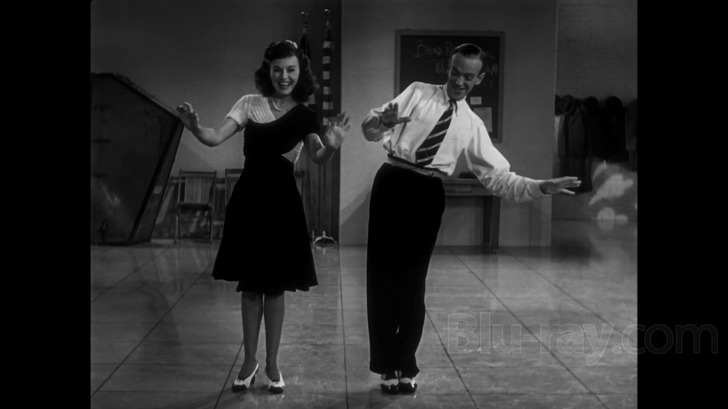
- Audio Commentary with Tom Santopietro. This is a generally interesting and informative commentary, though Santopietro has the odd habit of repeatedly introducing someone or something and then telling us "I'll talk more about that later".
- Trailer (1080p; 2:06). This is yet another faux trailer, something that Film Chest inexplicably does on a lot of their releases. What makes these so very, very odd is that trailers, unlike most films, are almost always in the public domain, so using the real trailer (even if it weren't restored) would seem to be pretty easy.
- Before and After Restoration Demontration (1080p; 00:54)
Second Chorus Blu-ray Movie, Overall Score and Recommendation 

Second Chorus may not in fact be top tier Astaire, but even second tier is usually head and shoulders (not to mention dancing feet) above the bulk of "all singing, all dancing" films that were such regular offerings back in the thirties and forties. Sadly, though, Second Chorus fell into the public domain and then into very bad disrepair, something even a lesser Astaire effort like this didn't deserve. Film Chest has done a largely laudable visual restoration here, one that artfully balances a fairly aggressive scrubbing with an effort not to totally wipe the film of grain. Unfortunately, someone also tried to "improve" the audio and failed pretty miserably. The result is a mixed bag. Astaire lovers may well want to check this out, as it's certainly the nicest Second Chorus has looked for decades. They just might want to have the sound off.
Similar titles
Similar titles you might also like

Daddy Long Legs
1955

Let's Make Love
Limited Edition to 3000
1960

Shall We Dance
1937

Hit the Deck
Warner Archive Collection
1955

Road to Rio
1947

Mamma Mia! Here We Go Again
Sing-Along Edition
2018

Good News
Warner Archive Collection
1947

The Gang's All Here
Limited Edition to 3000
1943

High Society
Warner Archive Collection | Remastered
1956

The Broadway Melody
Warner Archive Collection
1929

Royal Wedding
1951

Funny Face
1957

Guys and Dolls
Warner Archive Collection
1955

Romance on the High Seas
Warner Archive Collection
1948

42nd Street
Warner Archive Collection
1933

Cover Girl
Limited Edition to 3000 - SOLD OUT
1944

Top Hat
1935

The Gay Divorcee
1934

Lullaby of Broadway
Warner Archive Collection
1951

The Band Wagon
1953